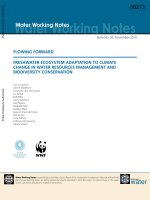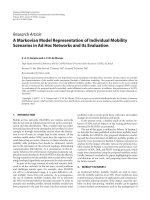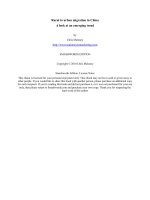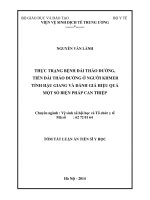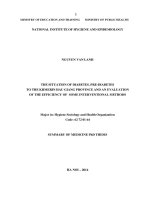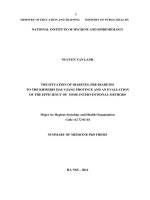the situation of diabetes, pre-diabetes to the khmer in hau giang province and an evaluation of the efficacy of some interventional methods
Bạn đang xem bản rút gọn của tài liệu. Xem và tải ngay bản đầy đủ của tài liệu tại đây (264.14 KB, 28 trang )
1
MINISTRY OF EDUCATION AND TRAINING MINISTRY OF PUBLIC HEALTH
NATIONAL INSTITUTE OF HYGIENE AND EPIDEMIOLOGY
NGUYEN VAN LANH
THE SITUATION OF DIABETES, PRE-DIABETES
TO THE KHMERIN HAU GIANG PROVINCE AND AN EVALUATION
OF THE EFFICIENCY OF SOME INTERVENTIONAL METHODS
Major in: Hygiene Sociology and Health Organization
Code: 62 72 01 64
SUMMARY OF MEDICINE PhD THESIS
HA NOI – 2014
2
PROJECT WAS FINISHED AT NATIONAL INSTITUTE OF HYGIENE AND
EPIDEMIOLOGY
Supervisor
1.Reader. A/Prof. PhD Nguyen Van Tap
2.Reader. A/Prof. PhD Nguyen Duc Trong
Referee 1: A/Prof. PhD Ngo Van Toan, Hanoi Medical University
Referee 2: Prof. PhD Le Van Nghi, Military Medical Academy
Referee 3: A/Prof. PhD Do Thi Khanh Hy, Central Hospital of Gerontology
Thesis will be defended at Academic Committee of the Institute discussing at National Institute of
Hygiene and Epidemiology
Date :……. Month:……Year: 2014
For further information about thesis at
1. National Library
2. National Institute of Hygiene and Epidemiology Library
3
ABBREVIATION
BMI Body Mass Index Chỉ số khối cơ thể
CDC Center of Disease Control Trung tâm kiểm soát dịch bệnh Mỹ
Cs Et al Cộng sự
ĐTĐ Diabetes
Đái tháo đường
EASD European Association for the
Study of Diabetes,
Hiệp hội nghiên cứu đái tháo đường
Châu Âu
ESC European Society of
Cardiology
Hội tim mạch Châu Âu
FFAs Free fat acides Các axit béo tự do
FINDRISC Finnish Diabetes Risk Score Thang điểm nguy cơ đái tháo đường
Phần Lan
GDNG Impaired Glucose Tolerance
(IGT)
Giảm dung nạp glucose
HA Blood Pressure Huyết áp
HATT Huyết áp tâm thu
HATTr Huyết áp tâm trương
HbA
1
c Hemoglobine A
1
c Hemoglobine A
1
c
HDL.C High Density lipoprotein
cholesterol
Lipoprotein gắn cholesterol có tỷ
trọng cao
IDF International Diabetes
Foundation
Liên đoàn đái tháo đường quốc tế
LDL.c Low Density lipoprotein
cholesterol
Lipoprotein gắn cholesterol có tỷ
trọng thấp
MCT Body Fat Mỡ cơ thể
MNT Visceral Fat Mỡ nội tạng
NPDNG Oral Glucose Tolerance Test Nghiệm pháp dung nạp glucose
NXB Publisher Nhà xuất bản
OR Odd ratio Tỷ số chênh
RR Risk ratio Tỷ số nguy cơ
TG Triglycerid
THCS Junior High School Trung học cơ sở
THPT Senior High School Trung học phổ thông
4
THA Hypertension Tăng huyết áp
TT- GDSK Truyền thông – giáo dục sức khỏe
TCYTTG World Heath Organisation Tổ chức y tế thế giới
YTNC Yếu tố nguy cơ
TĐTĐ Prediabetes Tiền đái tháo đường
5
INTRODUCTION
Diabetes is not a contagious disease, has an upward trend. It effects
on the health of working-age people in all over the world. In 2003, there
are 171,4 million people suffered from diabetes, it is predicted to be
double in 2030. Every day, there are about 8700 people die because of
diabetes.
The prevalence of diabetes is different from each continents and
areas. In Singapore, the rate is 8,6%, Malaysia is 3,1%; that of Kampomg
Cham, Cambodia (2005) of over 25-year-old people is 11%.
In Viet Nam, Ngo Thanh Nguyen said that, at Bien Hoa (2011), the
prevalence of diabetes of over 30-year-old people is 8.1%, including, the
diagnosis is about 69,1%. Huynh Nhan Hai, (2012), at Vinh Long, the
prevalence of diabetes is 19,4%, type 2 diabetes is 7,4%. Diabetes is still
a burden to economic and society. However, the disease can be prevented
and managed to have treatment, if it is consulted and treated early.
Moreover, a balance diet and proper exercises can help reduce the risk of
prevalence and complication.
In Hau Giang, a rice production place of Southwest Vietnam, still a
poor province in urbanization. Khmer make up 22% of the population.
They have their own habit, particulars; but have narrow knowledge about
diabetes and how to prevent it. Through a survey at Nga Bay County
Town, in 2009, it is found that the prevalence made up 11,8% and it
trends to increase. However, there is no research related to the prevalence
of diabetes of the Khmer in our country.
It is essential to determine the prevalence of diabetes, pre-diabetes of the
Khmer, find proper methods to prevent the disease. Moreover, it is to
determine the risk of disease for Khmer and have methods to help
medical station to manage diabetes. It is shown through the 2 following
purposes of the research project:
1. To determine the rate of pre-diabetes, diabetes and some factors
related to diabetes of Khmer from 45 years old to over at Hau Giang
Province in 2011.
2. To evaluate the effect of some preventive methods of diabetes of
Khmer from 45 years old to over at the research area.
New points of science and reality value of the topic
- It is a research which can determine the prevalence of diabetes of
the Khmer
6
- It can determine the prevalence of pre-diabetes of the Khmer in
community
- It can determine some factors related to type-2 diabetes of Khmer,
proof that the intervention of educational communication can change
behaviors and manage diabetes treatment at medical station. At the same
time, having a combination with Khmer clinic staff, mass organization
and religious authorities in the local area to organize prevention work of
diabetes in the community.
THESIS’S STRUCTURE
The thesis includes 139 pages with 41 tables, 2 diagrams, 5 graphs and 3
pictures.
Including: 2 pages of Pose problems, 33 pages of overview, 30 pages of
subjects and research methods, 36 pages of research results, 35 pages of
discussion, 2 pages of conclusion and 1 page of petition.
There are 130 references, in Vietnamese (64), in English (66).
CHAPTER 1
OVERVIEW
1.1 Overview of diabetes
1.1.1. Concepts of type-2 diabetes
According to American Diabetes Association (ADA), in 2006, “Type 2
diabetes is a metabolic disorder that is characterized by high blood
glucose in the context of insulin resistance and relative
insulin deficiency”.
According to International Diabetes Foundation (IDF), in 2010,
“Diabetes is a group of metabolic disorders of carbohydrate metabolism
characterized by high blood glucose levels and usually resulting from
insufficient production of the hormone insulin or an ineffective response
of cells to insulin. Type-2 diabetes is characterized by insulin resistance
and relative insulin deficiency, one of the two dysfunctions can occur at
the time of clinical symptoms of diabetes”.
“Pre-diabetes is a condition of glucose transformation deficiency
which includes Impaired Fasting Glucose – IFG and Impaired Glucose
Tolerance – IGT”.
1.1.2. Diagnosis and classification of diabetes
1.1.2.1. Diagnosis of diabetes:
Standards for diagnosis of diabetes and blood sugar disorder of
WHO – IDF in 2008 updated in 2010 and the diagnosis standards of
ADA/WHO in 2010:
7
- Diabetes
Fasting blood glucose ≥ 7mmol/l (≥ 126mg/dl)
Random blood glucose or after 2-hour glucose tolerance (≥ 11,1
mmol/- ≥200mg/dl l), Or the patient was diagnosed and being treated
diabetes.
Or the concentration of HbA 1c ≥ 6,5%
- Pre-diabetes
Impaired glucose tolerance (IGT): fasting blood glucose is from 5,6
- < 7 mmol/l and (100 < 126 mg/dl)
Or blood glucose after 2-hour glucose tolerance is from 7,8 - < 11,1
mmol/l (140 - < 200 mg/dl), or Impaired Fasting Glucose (IFG)
Impaired Fasting Glucose is from 5,6 - < 7 mmol/l and/ or after 2-
hour glucose tolerance is under 7,8 mmol/l
Or the concentration of HbA 1c is from 5,7% - < 6,5%
- Normal. Fasting blood glucose is < 5,6 mmol/l
1.1.2.2. Classification of diabetes
According to American Diabetes Association and European
Diabetes Association
- Type 1 diabetes: the beta cells are destroyed by the immune
system and no longer secrete insulin. It can be divided into two
categories: structure with and without autoimmune. It does not depend on
cytoplasmic antibodies.
- Type 2 diabetes: It is characterized by insulin resistance, relative
insulin deficiency, and increased production of glucose by the liver,
abnormal fat transformation. Obesity caused from visceral fat or central
obesity.
- Other specific types: Diabetes due to absent beta cell function or
absent insulin action due to genetics.
- Gestational diabetes: occur while being pregnant
1.1.3. Factors related to Type 2 diabetes
In recent years, people have proved that there are many factors
related to diabetes. According to American National Institute of Health,
factors that can cause Type 2 diabetes include:
- People ≥ 45 years old, 90-95% suffers from Type 2 diabetes
- Overweight (BMI ≥ 23 for Asian people) male pattern obesity
(waist size ≥ 90 cm to male and ≥ 80 to female, high WHR)
- Blood pressure 140/90 mmHg or higher
- Have a family prehistory of diabetes
8
- Woman had a prehistory of gestational diabetes or gave big child
(≥ 4kg)
- People who have trouble with impaired fasting glucose or
impaired glucose tolerance
- Having high rate of cholesterol or triglycerides
- Less physical activities
Besides that, people also record other factors such as: high rate of
beer consumption or smoking are also be the causes of diabetes.
1.2. Intervention model to prevent diabetes
The Resolution 42.36 of WHA has introduced a development of
Diabetes Prevention Program within national level, engagement of
countries to prevent diabetes. United Nations (2006) published the
Resolution UN61/225 on the prevention of diabetes with the message:
Developing policies to treat, prevent and taking care of diabetes.
International Diabetes Foundation (IDF) has designed a national diabetes
prevention program which focuses on enhancing the awareness of
community through communication and education. Level-1 prevention is
to reduce the prevalence of diabetes. It is also to change the behaviors and
to have early detection of the disease to reduce complications, fatality and
enhance the quality of life for people.
In Viet Nam, Ministry of Health has developed some programs for
preventing some infected diseases in the period of 2010-2020 with the
purpose to reduce the prevalence and death of diabetes. With the
following activities:
Organizing communication to change behaviors: to propaganda to
enhance the awareness of people about the risk of diabetes to prevent.
Specifically, it is to change bad behaviors, help people to know how to
prevent and detect diabetes. Therefore, they can avoid complication.
Organizing evaluation in the community:
Previous studies affirmed that diabetes can be managed and prevented.
We have intervened to prevent diabetes for Khmer at medical station by
method as follows:
Change our diet: it is recommended to change our habit to reduce the
disorder of blood lipids including the decrease of fat, cholesterol, the
increase of protein with low fat, fiber.
To reinforce physical activities: doing exercise regularly can
prevent Type 2 diabetes because exercising help reducing the resistance
of insulin. It is also easy to transform glucose to reduce plasma glucose.
A scientific Exercising can fresh our mind, reduce stress and avoid
9
insulin resistance. An increase of physical activities can reduce the risk of
obesity and eliminate some factors caused diabetes. It is encouraged to
lessen drinking hard and stop smoking.
CHAPTER 2
SUBJECTS AND RESEARCH METHODS
2.1. Subject
The Khmer who are 45 years old and over, living in Hau Giang
Province within the study period
2.2. Location: Residents live in: Long My, Chau Thanh A District and
Vi Thuy District, Hau Giang Province.
2.3. Period: From 09/2011 to 10/2013. The first period is for
investigation and the second period is for intervention research (2 years).
2.4. Research methods
2.4.1. Cross-sectional descriptive study and community intervention
2.4.2 Cross-sectional descriptive study
- Sample size. With single random sampling formula:
N = Z²
(1-α/2)
x
p(1
-
p)
x DE
d
²
Including: Z
(1-α/2)
= 1,96, with the accuracy of 95%. d=0,03 is
selected odd. Design coefficient DE = 2. p = 0,15. p is the rate of diabetes
and pre-diabetes under the study on Khmer in Cambodia in 2005. n = 1100.
- Sampling: Random sampling of 3 districts /7 districts, county
town, Hau Giang Province are: Long My, Chau Thanh A District and Vi
Thuy District. Two communes will be selected from each district,
Sample size is 1100 people /4792 people /6 communes. The list of Khmer
who are over 45 years old will be selected from each commune which
corresponds with k.
2.4.3. Community intervention
+ The research sample size is calculated by the following formula
- n: Minimum sample size for each group (intervention and control group)
- p1: Estimation rate of pre-diabetes, diabetes for the intervention group is
0,2
- p2: Estimation rate of pre-diabetes, diabetes for the control group is
0,2982
- α: Statistical significance with the accuracy of 95% (α=0,05)
- β: Probability of the II error. With β=0,2
- Z² (α,β) = 7,9
10
The rate of pre-diabetes , diabetes desired 10% reduction compared
to pre-intervention ( 29.82 % ) . The rate of pre-diabetes , diabetes
mellitus after intervention was 20 % . So ( p2 ) is estimated to 0,2982 % ,
due to the rate pre-diabetes , diabetes does not change or less change .
Placing into the above formula, we have the minimum sample size
is 302.
So, the sample size after 2-year taking intervention at 2
communes has the smallest n with 302 in the community of 45-year-old-
and-over Khmer. At the 2 control commune, we also choose the smallest
sample size 369 to investigate after taking intervention.
Sampling: taking random sampling at the two intervention
communes are Cai Tac and Bay Ngan of Chau Thanh A District. For that
of control group are Vi Thuy Commune and Vinh Trung Commune of Vi
Thuy District.
2.4.4 Organization of intervention
Model “Commune medical station in diabetes prevention for
Khmer”
- Interventional actions
It includes 5 activities for intervention, prevention of pre-diabetes
and diabetes as follows: (1) develop resources and network at medical
station which is under the interventional model; (2) Educating community
health through communication; (3) consulting to change behaviors; (4)
doing exercises; to monitor for early detection and to manage the work of
examining and treating at commune medical station (5).
- To evaluate the efficiency of intervention model
Efficiency index (CSHQ)
CSHQ (%)=
│p1
–
p2
│
x 100
│p1│
p1 is the rate of pre-intervention.
p2 the rate of post-intervention
The efficiency of intervention (HQCT)
HQCT (%) = CSHQ
intervention
– CSHQ
control
2.5. Officials in charge
Graduate student is the project’s director, directly manage, co-
ordinate with the staff of Health Department, District medical center,
medical office, commune medical station, collaborator of hamlet medical
station.
2.6. To minimize research errors
11
To manage, reduce research errors through: sampling, investigator,
gathering information, tools, machines and medical equipment,
standardizing data.
2.7. Data processing
EPI-INFO software 3.5.3, Excel 2003 and Epi 6.0 are used for
analyzing through testing χ
2
, OR, Multivariate Regression Analysis.
CHAPTER 3
RESEARCH’S RESULT
3.1. THE PREVALENCE OF PRE-DIABETES, DIABETES AND
SOME RELATED FACTORS 3.1.1 The prevalence of pre-diabetes,
diabetes to the Khmer
Table 3.2. The prevalence of pre-diabetes and diabetes to the subjects
Content
Quantity
Percentage
(%)
Do not get diabetes
772
70,2
Pre
-
diabetes
197
17,9
Diabetes
131
11,9
Through a survey of 1000 people, the prevalence of pre-diabetes
was 17,9%, diabetes is 11,9%, including 9,4% of the new detection, The
rate of new detection made up 78,6% .
3.1.2. Knowledge, attitude, practice on preventing diabetes to Khmer
41,1% has knowledge about the disease symptoms; 38,1% for the
risk factors; the consequence of disease is 54,1%; 45,9% for preventive
methods; 41,1% know how to detect the disease. 61,9% has bad attitude
for the prevention of diabetes; the good one is 38,1%.
The percentage of people doing exercises is 32,5%, 35,2% is for
balancing nutrition of daily meal, acquiring the advices and health
communication, 32,5% takes periodical health examination and 41,1% do
not abuse beer or cigarettes.
12
3.1.3. Some factor related to Khmer who get diabetes
Table 3.10. The relationship
Demography Total
The
prevalen
ce of
diabetes
Percenta
ge %
P
Sex
Male
458
52
11,4
<0,05
Female
642
79
12,3
Age
45
–
54
519
53
10,2
<0,05
55
–
64
333
37
11,1
≥ 65
248
41
16,5
Job
Farmer
626
82
13,1
<0,05
Employee
61
1
1,6
Merchant
142
12
8,5
Hired labor
271
36
13,3
Educati
onal
level
Literacy
384
72
18,8
<0,05
Primary
550
41
7,5
High
school,
ollege
145 18 12,4
Financia
l status
Fairly
–
have
enough to eat
295 32 10,8
>0,05
Poor
–
poor
threshold
805 99 12,3
between demography and diabetes
The prevalence of diabetes of male is 11,4% while that of female is
12,3%,. Age group has the smallest prevalence of diabetes is 45 – 54
made up 10,2%, the highest is over 65 with 16,5 %. The prevalence of
diabetes of people who live in the countryside is 12,7 %. The prevalence
of diabetes of farmers is 13,1%, that of hired labor is 13,3%
The prevalence of diabetes of literacy people is 18,8%; 12,4% is of
people who has high school level. It does not have statistical significance
to economic life.
13
Table 3.14. The relationship between lifestyle habits to diabetes
through multivariate regression analysis
Variable
Tot
al
Diabe
tes
%
OR
95% CI
P
Sugar diet
low sugar
consumption
511 37 7,2
2,0
1,30 -
3,34
0,0
1
high sugar
consumption
589 94 16,0
Fat diet
low fat
consumption
687 81 11,8
0,6
0,44 -1,08
0,1
0
high fat
consumption
413 50 12,1
Eating
after 20
o’clock
No
679
66
9,7
0,6
0,40 -0,90
0,0
1
Yes
421 65 15,4
Physical
activities
Yes
798
75
9,4
1,7
1,16 -2,75
0,0
1
Little
302
56
18,5
Drinking
alcohol/
day
No, little
510
59
11,6
0,5
0,28 -0,98
0,0
4
Yes
590 72 12,2
Smoking
No
728
83
11,4
2,2
1,16 -4,25
0,01
Yes
372
48
12,9
After multivariate regression analysis, it shows that:
People who have a high sugar consumption diet may double the risk
of diabetes in comparison with people who have a low sugar consumption
diet (p< 0,05)
People who do not eat after 20 o’clock has the risk of diabetes as
0.6 times as that of people who eat after 20 o’clock (p< 0,05)
People who do physical activities has the risk of diabetes as 1.7
times as that of people who do not do physical activities ( p<0,05)
People who do not drink alcohol during the day has the risk of
diabetes as 0.5 times as that of people who drink alcohol during the day
(p<0,5), There is a link between diabetes and smoking with p<0,05.
14
Table 3.15. The relationship between health indexes
Variable Total
Number
of people
suffering
from
diabetes
%
OR
95% CI
P
Belly size
Normal
918 105 11,4
0,6
0,3-1,1
0,03
High
182 26 14,3
Visceral
fat
Normal
853 72 8,4
3,4
2,3-4,9
0,01
High
247 59 23,9
Body fat
Normal
507 35 6,9
0,9
0,9-1,0
0,04
High
593 96 16,2
WHR
Normal
787 84 10,7
1,4
1,0-2,1
0,04
High
313 47 15
BMI
<23
691 51 7,4
2,3
1,5-3,6
0,01
≥23
409 80 19,6
Blood
Pressure
Normal
672 55 8,2
1,7
1,1-2,5
0,01
High
blood
pressure
428 76 17,8
People who have normal belly size has the risk of diabetes as 0,6 as
that of high belly size (p< 0,05)
People who have high visceral fat has the risk of diabetes as 3,4 as
that of low visceral fat (p< 0,05)
People who have high WHR has the risk of diabetes as 1,4 as that of
normal WHR (p< 0,05).
People who have BMI >=23 has the risk of diabetes as 2,3 as that of
people who have BMI<2,3 (p< 0,05)
People who have high blood pressure has the risk of diabetes as 1,7
as that of people who have normal blood pressure (p< 0,05)
15
Table 3.17. Some factor related to diabetes of Khmer according to
FINDRISC
Parameter
Area KTC 95%
Cutting
point
P
Scal
e
Age
0,74 0,69 – 0,78 53 <0,05
BMI
0,61
0,55
-
0,66
23 <0,05
Belly size
0,78 0,74 – 0,82 77 <0,05
Prehistory of High Blood
Pressure
0,38 0,32 – 0,43 <0,05
Out of the scale
Systolic hypertension
0,65 0,61 – 0,69 120 <0,05
Diastolic hype
rtension
0,63 0,58 – 0,68 80 <0,05
Body fat
0,59
0,53
-
0,64
31 <0,05
Visceral fat
0,60 0,55 – 0,65 4 <0,05
Age, BMI and belly size are the three key factor related to
FINDRISC. Systolic hypertension, diastolic hypertension and visceral fat
are the most related factors which are out of the scale of FINDRISC to
the Khmer suffering from pre-diabetes.
To analysis the development of Type 2 diabetes for the next ten
years of the Khmer is normal, the low risk is 55,3%, that of average is
33,8% and high risk of development is 8,3%. It is estimated that Type 2
diabetes will increase 8,26% for the next ten years in 2021.
For people suffering from pre-diabetes, it can eliminate the low rate
with 41,6%, for that of average rate is 36,5% and the high rate is 16,8%.
It is estimated that the prevalence of Type 2 diabetes for the next 10 years
of the Khmer will be 13,39%.
3.2. AN EVALUATION OF THE EFFICIENCY OF
INTERVENTIONAL MODEL ON THE PREVETION OF PRE-
DIABETES, DIABETES TO THE KHMER
Intervention “Commune medical station with diabetes prevention”,
the result is as follows:
3.2.1. Health education through communication
16
Table 3.20 To compare the knowledge of Khmer after the intervention.
Content
Right
knowledge
P
CSHQ
Intervent
ional
efficienc
y
(%)
Nu
mbe
r
%
Risk
factors
Intervention
(n=302)
Before
139 46,0
0,01
72,8
43,8
After 240 79,5
Control
(n=369)
Before
155 42,0
0,01
29,0
After
200
54,2
Sympto
ms
Intervention
(n=302)
Before
154 51,0
0,01
57,8
11,9
After
243
80,5
Control
(n=369)
Before
140
37,9
0,01
45,9
After 204 55,3
Preventi
on
Intervention
(n=302)
Before
158 52,3
0,01
14,5
5,5
After
181
59,9
Control
(n=369)
Before
53
14,4
0,06
9,0
After
58
15,7
The rate of people having knowledge of diabetes’s risk factor before
and after intervention is 43,8%.The rate of people having knowledge of
diabetes detection before and after intervention is 11,9% . The rate of
people having knowledge of diabetes prevention before and after
intervention is5,5%
3.2.2. To evaluate the consulting program of changing behaviors
Table 3.21. The behavior changes after the intervention
Behaviors
Eat more
P
CSHQ
HQC
T
(%)
Numb
er
%
Eat sweet
things
Interventio
n
(n=302)
Before
131
43,4
0,01
35,3
35,3
After
85
28,1
Control
(n=369)
Before
208
56,4
<0,0
0,31
After
219
59,3
Fat
Interventio
n
Before
86
28,5
0,01
43,2
43,2
After
49
16,2
17
(n=302)
Control
(n=369)
Before
144
39,0
0,23
<0,0
After
156
42,3
Fatty
substance
Interventio
n
(n=302)
Before
83
27,
5
0,17
18,2
0,2
After
68
22,5
Control
(n=369)
Before
129
35,0
0,02
18,0
After
106
28,7
Eating
vegetables,
fruits
Interventio
n
(n=302)
Before
131
43,4
0,01
63,4
63,4
After
214
70,9
Control
(n=369)
Before
208
56,4
0,01
<0,0
After
173
46,9
Eating after
20 o’clock
Interventio
n
(n=302)
Before
271
73,4
<0,01
27,2
27,7
After
197
53,4
Control
(n=369)
Before
150
49,7
<0,01
<0,0
After
218
72,2
Physical
activities
Interventio
n
(n=302)
Before
220
72,8
<0,01
17,3
16,5
After
258
85,4
Control
(n=369)
Before
279
75,6
0,85
0,8
After
281
76,2
Drinking
beer,
alcohol
Interventio
n
(n=302)
Before
141
46,7
<0,01
75,8
63,6
After
34
11,3
Control
(n=369)
Before
173
46,9
0,01
12,2
After
152
41,2
The interventional efficiency of controlling eating sweet things is
35,3%. The control rate of fat is 43,2%, that of fatty substance before and
after intervention is 0,2%. The rate of eating vegetables and fruits before
and after intervention has the interventional efficiency of 63,4%(p
<0,001). The interventional efficiency of the rate of night eating is 27,7%.
3.2.3 Assessment of doing exercises changing health index
18
Table 3.24 and 3.25. Comparing the change of health index after intervention.
Behavior
High
P
CSHQ
HQCT
(%)
SL
(%)
Waist
Intervention
(n=302)
Before
Intervention
51 16,9
0,01
37,3
27
After
Intervention
32 10,6
Randomized
Controlled trial
(n=369)
Before
Intervention
68
18,4
0,18
10,3
After
Intervention
61
16,5
Visceral Fat
Intervention
(n=302)
Before
Intervention
220
72,8
0,53
8,8
8,8
After
Intervention
227
75,2
Randomized
Controlled trial
(n=369)
Before
Intervention
288
78,0
0,01
0,0
After
Intervention
209
56,6
Body
Fat
Intervention
(n=302)
Before
Intervention
183
60,6
0,01
53,6
53
After
Intervention
85
28,1
Randomized
Controlled trial
(n=369)
Before
Intervention
198
53,7
0,03
0,0
After
Intervention
218
59,1
BMI
Intervention
(n=302)
Before
Intervention
110
36,4
<0,01
20,9
20,9
After
Intervention
87
28,8
Randomized
Controlled trial
(n=369)
Before
Intervention
145
39,3
<0,01
0,0
After
Intervention
187
50,7
Blood
Pressure
Intervention
(n=302)
Before
Intervention
102
33,8
0,01
20,7
9,8
After Intervention
81
26,8
Randomized
Controlled trial
(n=369)
Before
Intervention
119
32,2
0,04
10,9
After Intervention
106
28,7
19
Ratio of having high the waist before and after intervention has 27
percent of interventional effectiveness. Comparing to visceral fat high
level before and after intervention has 8,8 percent of interventional
effectiveness. Ratio of high body fat before and after intervention has
over 53,6 percent of interventional effectiveness , ratio of over 23 BMI
before and after intervention has over 20,9 percent of interventional
effectiveness. Ratio of hypertension before and after intervention has 9,8
percent of interventional effectiveness.
3.2.4 Situation of medical examine and medical treatment of diabetes
at communal medical station
Table 3.26 Comparing the situation of medical examine at communal
medical station after intervention
medical examine
Medical
examine
of
diabetes
medical
examine of
other
disease
total
P
CSHQ
(%)
HQCT
(%)
SL
%
S
L
%
Interve
ntion
Before
Intervention
246
2,4
9870
97,6
10116
<0,05
54,2
48,6
After
Intervention
780
5,7
12970
94,3
13750
Rando
mized
Contro
lled
trial
Before
Intervention
148
1,8
8462
98,2
8710
<0,05
5,5
After
Intervention
201
1,9
105
66
98,1
10767
Ratio of patients examined medically before and after intervention
has 48,6 percent of effectiveness
Table 3.27. Comparing ratio of diabetes detection at communal medical station
Diabetes
Having
diabetes
Normal
Total
P
CSHQ
(%)
HQ
CT
(%)
SL
%
SL
%
Intervention
Before
Intervention
21
8,5
225
91,5
246
<0,05
44,7
6,4
After Intervention
95
12,1
685
87,9
780
Randomized
Controlled
trial
Before
Intervention
7
4,7
141
95,3
148
<0,05
38,3
After Intervention
13
6,5
1
88
93,5
201
20
Ratio of diabetes patients examined and detected at communal
medical station before and after intervention has 6,4 percent of
effectiveness
Table 3.28. Comparing ratio of pre diabetes detection at communal medical station
Content
Pre diabet
Normal
Total
P
CSHQ
(%)
HQCT
(%)
SL
%
SL
%
Intervention
Before
Intervention
27
10,9
219
89,1
246
<0,05
28,4
13,6
After
Intervention
109
14,0
671
86,0
780
Randomized
Controlled
trial
Before
Intervention
11
7,4
137
92,6
148
<0
,05
14,8
After
Intervention
17
8,5
184
91,5
201
Ratio of pre diabetes patients examined and detected at communal
medical station before and after intervention has interventional 13,6
percent of effectiveness
3.2.5. Assessment of interventional effectiveness in diabetes patients
Table 3.29 and Table 30. Comparing diabetes group’s health indexes
before and after intervention
Health indexes
High
Total
P
CSHQ
HQCT
(%)
SL
(%)
Waist
Intervention
Before
Intervention
7
18,9
37
0,12
14,2
14,2
After Intervention
6
16,2
37
Randomized
Controlled
trial
Before
Intervention
13
32,5
40
0,98
0,0
After
Intervention
13
32,5
40
Organ
Fat
Intervention
Before
Intervention
34
91,9
37
0,01
44,1
10,8
After
Intervention
19
51,3
37
Randomized
Controlled
trial
Before
Intervention
24
60,0
40
0,03
33,3
After
32
80,0
40
21
Intervention
Body
Fat
Intervention
Before
Intervention
22
59,5
37
0,01
13,3
9,3
After Intervention
20
54,1
37
Randomized
Controlled
trial
Before
Intervention
15
37,5
40
0,01
4,0
After
Intervention
14
35,0
40
BMI
Intervention
Before
Intervention
26
70,3
37
0,01
38,5
12,4
After
Intervention
16
43,2
37
Randomized
Controlled
trial
Before
Intervention
23
57,5
40
0,
03
26
After
Intervention
29
72,5
40
Blood
Pressure
Intervention
Before
Intervention
20
54,1
37
0,37
17,8
2,5
After
Intervention
17
45,9
37
Randomized
Controlled
trial
Before
Intervention
27
67,5
40
0,07
15,3
After
Interven
tion
25
62,5
40
Comparing ratio of waist in diabetes patients before and after
intervention has 14,2 percent of interventional effectiveness
Comparing Ratio of visceral fat level in diabetes patients before and
after intervention has 10,8 percent of interventional effectiveness
Comparing ratio of body fat in diabetes patients before and after
intervention 9,3 percent of interventional effectiveness
Comparing ratio of BMI in diabetes patients before and after
intervention has 12,4 percent of interventional effectiveness
Comparing ratio of hypertension in diabetes patients before and after
intervention has 2,5 percent of interventional effectiveness
22
3.2.6. Assessment of health indexes in pre diabetes patients
Table.3.31; 3.32. Comparing health indexes in pre diabetes patients
Health indexes High Total
P
CSHQ
HQCT
(%)
SL (%)
Waist Intervention
Before
Intervention
22 37,3
59
0,01
20,0
9,2
After Intervention
10 16,9
59
Randomized
Controlled
trial
Before
Intervention
22 37,3
59
0,21
10,8
After
Intervention
18 30,5
59
Organ Fat Intervention
Before
Intervention
49 83,1
59
0,01
16,4
8,5
After
Intervention
41 69,4
59
Randomized
Controlled
trial
Before
Intervention
50 84,7
59
0,34
7,9
After
Intervention
46 78,0
59
Body Fat Intervention
Before
Intervention
29 49,2
59
0,55
13,3
10,0
After
Intervention
25 42,4
59
Randomized
Controlled
trial
Before
Intervention
31 52,5
59
0,01
3,3
After
Intervention
30 50,9
59
BMI Intervention
Before
Intervention
53 89,8
59
0,01
15,1
7,7
After
Intervention
45 76,2
59
Randomized
Controlled
trial
Before
Intervention
54 91,5
59
0,12
7,4
After
Intervention
50 84,7
59
Blood
Pressure
Intervention
Before
Intervention
26 44,1
59
0,01
23,3
7,2
After
Intervention
20 33,8
59
Randomized
Controlled
trial
Before
Intervention
25 42,4
59
0,34
16,0
After
Intervention
21 35,6
59
23
Comparing ratio of waist in pre diabetes patients before and after
intervention has 9,2 percent of interventional effectiveness, ratio of
visceral fat level in pre diabetes patients before and after intervention has
8,5 percent of interventional effectiveness, ratio of body fat in pre
diabetes patients before and after intervention has 10,0 percent of
interventional effectiveness, ratio of BMI in pre diabetes patients before
and after intervention has 7,7 percent of interventional effectiveness, ratio
of hypertension in pre diabetes patients before and after intervention has
7,2 percent of interventional effectiveness
3.2.7 Assessment of intervention effectiveness of direct indexes
Table 3.33. Assessment of intervention effect about ratio of detected
diabetes, pre diabetes of Randomized Controlled trial group and
interventional group
Variable
High
Normal
Total
P
CSHQ
(%)
HQCT
(%)
SL
%
SL
%
Diabetes
Intervention
Before
Intervention
37
12,3
265
87,7
302
0,26
19,5
13,1
After
Intervention
30
9,9
272
90,1
302
Randomized
Controlled
trial
Before
Intervention
40
10,8
329
89,2
369
0,10
6,4
After
Intervention
37
10,1
332
89,9
369
Pre Diabetes
Intervention
Before
Intervention
59
22,3
206
77,7
265
0,01
43,9
38,4
After
Intervention
34
12,5
238
87,5
272
Randomized
Controlled
trial
Before
Intervention
59
17,9
270
82,1
329
0,10
5,5
After
Intervention
54
16,26
264
83,74
318
Comparing ratio of detected diabetes before and after intervention
has1 13,1 percent of interventional effectiveness, ratio of having pre
24
diabetes before and after intervention has 38,4 percent of interventional
effectiveness
The situation after two-year intervention has 8,11 percent of the
number of diabetes patients tested for blood sugar with moderate level;
and 13,51 percent of diabetes patients change into pre diabetes.
Changes after intervention: there are 49,15 percent of pre diabetes
after intervention being tested blood sugar with moderate level. Pre
diabetes people changing into diabetes have 1,7 percent of ratio
3.2.8. Assessing effectiveness of work of organization and
management practicing interventional measures
Work of organizing steering committee to practice the work of
diabetes prevention in community gets high effect. For example, work of
steering committee get 100%, work of organizing a training course for
officials at commune and hamlet, work of diabetes prevention at Cai Tac
communal medical station gets 75%. Generally, other variables get from
95%
Contents about guiding and practicing the work of diabetes
prevention only have variable which guide how to do exercises and club’s
activities, Cai Tac communal medical station gets 91,66, both other
variables and other communes get over 95%
Chapter 4
DISCUSSION
4.1 RATIO OF PRE DIABETES – DIABETES AND SOME
RELEVANT FACTORS
4.1.1. Ratio of currently having pre diabetes and diabetes
The ratio of Khmer getting diabetes is 11,9 % and ratio of pre
diabetes is 17,9%. Ratio of getting diabetes which is higher than Cao My
Phuong’s research in Tra Vinh province in 2011 is 9,6 % and higher than
some researches about the residents in southwest region
4.1.2 Some relevant factors
Socio-economic factors: ratio of male getting diabetes is 11,4 %,
ratio of female is 12,3%. 45-54 age group getting diabetes is 10,2%, over
65 age group is 16,5%. 12,7 percent of rural people has diabetes. Ratio of
getting diabetes with the lowest level in farmer group is 13,1%. Illiterate
residents getting diabetes is 18,8 percent, the ones whose secondary
education is 12,4 percent
Our research result shows that diabetes is related to age factors,
peoples, home economy, prehistoric family having diabetes, giving birth
25
over 4000 gram. This is also consistent with medical literature and
previous researches
Understanding and practicing disease prevention
Ratio of Khmer understanding correctly about diabetes symptoms,
risk factors, disease consequences, how to prevent disease is very low,
compared to previous researches. This is suitable because their academic
standard is very low and ratio of people who do not understand
Vietnamese is very high. Therefore, communication works are mainly
based on dignitaries in pagoda, propagandizing effectively high. Having
no knowledge is related to the effectiveness of diabetes prevention
Some intermediary health indexes
The person whose normal waist has 0,6 times as many diabetes
risks as the person whose high waist (p<0.05)
The person whose high visceral fat level has 3,4 times as many
diabetes risks as the person whose normal visceral fat level (p<0.05)
The person whose high WHR indexes has 1,4 times as many
diabetes risks as the person whose normal WHR indexes (p<0.05)
The person whose >=23 BMI indexes has 2,3 times as many
diabetes risks as the person whose < 2,3 BMI indexes (p<0,05)
The person whose high blood pressure has 1,7 times as many
diabetes risks as the person whose normal blood pressure (p<0.05)
Our research is also consistent with Ta Van Binh’s research (2003),
having diabetes ratio result in hypertension group which is twice as high
as research in hue of Ho Thi Thuy Vuong, Nguyen Hai Thuy (2009)
shows that ratio of diabetes in group having ratio of high body fat is much
higher than group having no ratio of high body fat (16,7% compared to
3,3%) and it is also consistent with domestic researches and foreign
researches. Therefore, these are risk factors that need attention
intervention in community
4.2. ASSESSMENT OF INTERVENTIONAL EFECTIVENESS IN
COMMUNITY IN DIABETES PREVENTION
After two-year model intervention at communal medical station, it
shows that the result affects clearly in community about diabetes
prevention, expressing through some below activities:
Health education communication: Ratio of understanding about
diabetes before and after intervention has higher interventional
effectiveness. This is consistent with previous researches. That means
their knowledge increases when they are educated. The thing has more
deserving of concern is that research subjects are Khmer, so
